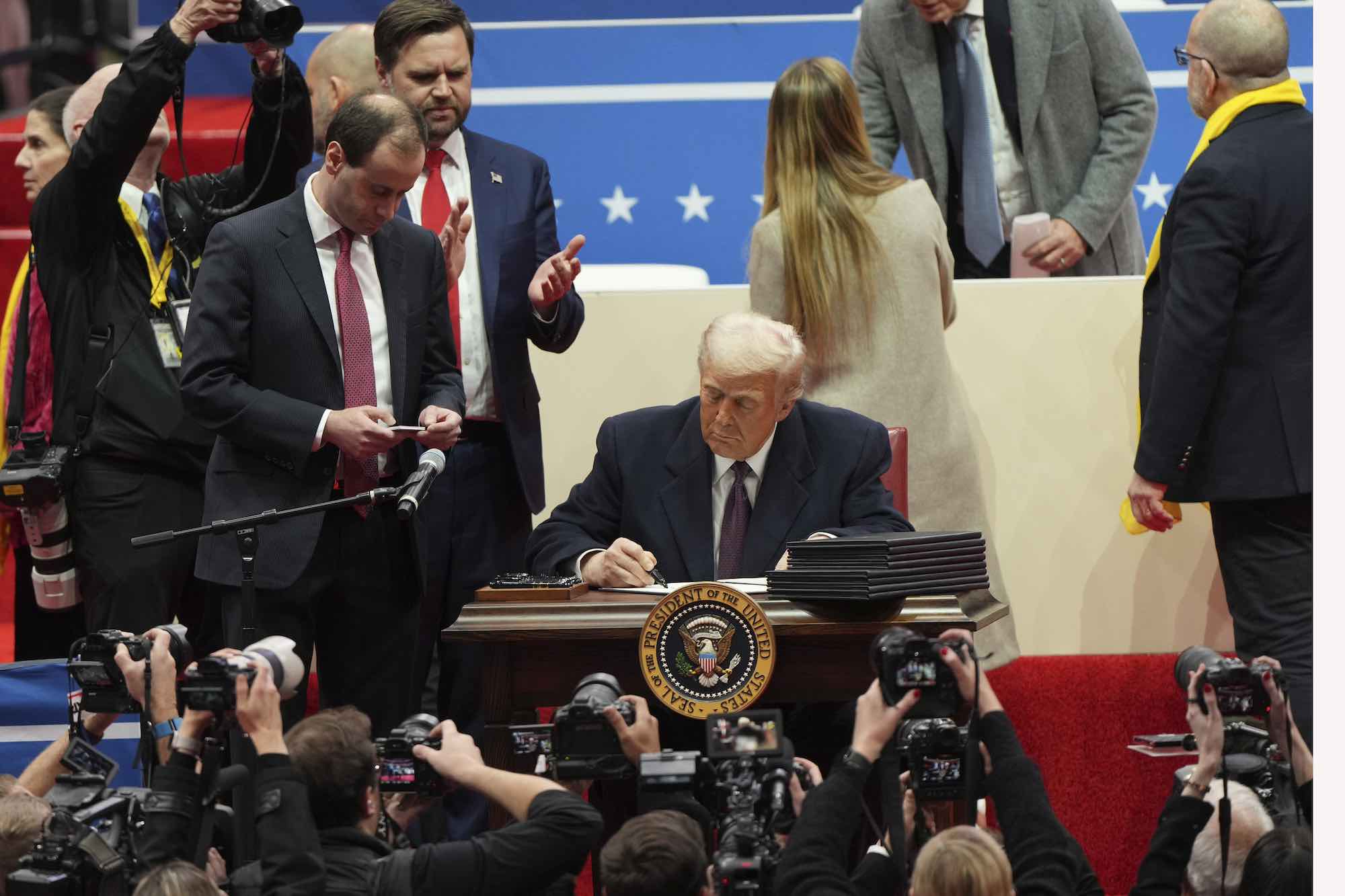Donald Trump, newly installed for his second term as president of the United States, has directed his government to begin a withdrawal from the Paris Agreement, and taken aim at a wide swathe of pro-environment and clean energy policies put in place by the outgoing Biden administration.
Within the first few hours of being sworn in as the 47th president of the United States, Donald Trump signed off on a deluge of executive orders – directives to manage operations that are often used as a means of deploying presidential power without the need for Congress.
In his run for the presidency, Donald Trump took aim at everything from sharks and batteries (at times together) to “windmills”, electric vehicles, international treaties, and financial support for clean energy projects.
In this vein, many of the executive orders signed during Trump’s first few hours in office were performed as a sort of political theatre broadcast live to thousands of delighted MAGA supporters watching from the Capital One Arena in downtown Washington.
Among the orders – which covered everything from attempting to save TikTok, forcing government employees to return to in-person work, something to do with the architecture of public buildings, and reinstating the federal death penalty – Trump took the axe to the country’s environmental and clean energy transport policies.
Here’s what we know – and an early look into what it all might mean, for the climate and clean energy in US and the rest of the world.
Paris Agreement
Key amongst his initial orders was a direction to his new Ambassador to the United Nations to submit formal written notification of the country’s withdrawal from the Paris Agreement under the United Nations Framework Convention on Climate Change.
Given that Trump’s pick to be UN ambassador, representative Elise Stefanik, has yet to even start her confirmation hearings, and Biden’s ambassador, Linda Thomas-Greenfield, is on her way out, it is unclear precisely how quickly this formal notification will be enacted.
The executive order – with the snappy title of “Putting America First in International Environmental Agreements” makes a promise to “consider” a withdrawal from the Paris Agreement but also directs Stefanik to withdraw the country from “any agreement, pact, accord, or similar commitment made under the United Nations Framework Convention on Climate Change … immediately cease or revoke any purported financial commitment made by the United States.”
The order also immediately “revoked and rescinded” the United States’ International Climate Finance Plan to support developing countries respond to the effects of climate change.
As Rystad Energy’s head of new energies research, Artem Abramov, notes, the US exit from Paris was “one of the most certain expectations from a second Trump presidency.” But it’s nonetheless enormously depressing and concerning – and could hit differently this time around.
“We believe the process is likely to move faster this time compared with the exit framework set during Trump’s first term
“We also expect the US exit to have more significant international implications this time, as it could further strengthen support for anti-climate policies in Europe and other regions.
Virginie Derue, head of responsible investing research at AXA Investment Managers says the exit from Paris, while sending all the wrong messages, will not necessarily affect America’s emissions reduction trajectory.
“US emissions have been falling over the last 20 years, both in intensity and absolute terms, and including under Trump’s first term and outside the pandemic period,” Derue says.
“We may criticise the pace, which is below what is needed to meet the Paris Agreement’s ‘well below 2°C’ scenario; we may highlight the main driver of the move which relies on the gradual exit from coal, and hence question the future pace, but the country is unlikely to backtrack.”
Inflation Reduction Act
The new president has also ordered federal agencies to “immediately pause” the spending of money from the Inflation Reduction Act, former president Joe Biden’s signature climate law that provided hundreds of billions of dollars in subsidies to clean energy and other climate initiatives.
AXA Investment Managers’ Derue says it is not yet clear which of the IRA subsidies will be cut but there are some local forces in play which will act as safeguards.
“The Green Deal has generated jobs, growth, and tax revenues, most of them in Republican states. By 2024, $165bn had already been invested in Republican districts, almost three times as much as in Democratic lands.
“There will be some deceleration further down the road, for sure, but it is unlikely that plants which have recently opened will suddenly close, or that projects already launched are halted. It would be a political mistake ahead of the November 2026 Senate elections.”
Further, Derue adds, “the US is well aware of China’s increasing domination in green technologies, and it would be a strategic mistake to leave the field totally open.”
“Drill, baby, drill”
Donald Trump also used his executive powers to declare a “National Energy Emergency”, which experts are concerned could give the administration carte blanche to ramp-up production of fossil fuels.
This is particularly of concern for Alaska, which was the focus of a separate executive order designed to ‘unleash’ the state’s “abundant and largely untapped supply of natural resources including, among others, energy, mineral, timber, and seafood.”
The order described the current level of leasing, refining, and energy generation in the US as “far too inadequate” to meet the country’s needs and railed against “the harmful and shortsighted policies of the previous administration” for causing high energy prices.
Experts believe the so-called “energy emergency” is essentially Trump’s means of fulfilling his campaign promise to “drill, baby, drill!” Although, as AXA’s Derue points out, given the fact that oil and gas production reached their highest levels during Joe Biden’s presidency, this could be all for show.
“Increasing US production at any speed would increase the risk of overcapacity and would weigh on prices, which is not to US oil companies’ advantage,” she said on Tuesday.
But Rystad’s Abromov says there’s every reason to believe Trump will act “faster and harder” than he did during his first term, including on drilling and extraction.
“If he started with Arctic drilling being extended to protected areas, it would of course be significantly damaging for the planet. Whether the reality of climate change and increasing financial and social related costs will help prevent such a move is not a done deal, but it cannot yet be totally dismissed.”
Electric vehicles and clean transport
Another executive order title “Unleashing American Energy” demonstrates the scope of Trump and his administration’s efforts to reverse course on environmental and clean energy policies set forth in previous administrations.
The executive order reverses action by the Biden Administration to maintain U.S. leadership on clean cars and trucks, including revoking the goal that 50 percent of all new passenger cars and light trucks sold in 2030 be zero-emission vehicles.
Moreover, notes Rystad Energy’s Abramov, Section 7 of the “Unleashing American Energy” order introduces an immediate halt to federal funding for vehicle charging stations pending completion of a review process. It also calls for the end of a waiver to adopt zero-emission vehicle rules.
“We believe that the next development to monitor will be an attempt to repeal clean vehicle consumer tax credits (30D) introduced in Biden’s signature Inflation Reduction Act (IRA),” Abromov said on Tuesday.
“Having said that, this process might take longer and will require congressional approval.
“Meanwhile, the EV market share in the US hit a record high for new sales in December 2024, and EV sales are still expected to trend upwards in 2025, while the medium-term adoption outlook might be influenced by policy changes in coming months.”
The Sierra Club says that while this order signals Trump’s intent to roll back existing vehicle standards, it is not immediate; the administration must issue a notice and open a comment period for each rule-making.
State policies and economies will also be important in this instance, Sierra Club says.
“Currently, a dozen states (plus DC) follow one or more of the newest state clean transportation policies set by California under Clean Air Act authority.”
“The transition to electric vehicles is opening factories and putting people back to work across the country,” says Katherine García, Sierra Club’s director of the Clean Transportation for All campaign.
As an ironical side note, the “Unleashing American Energy” executive order also aims to establish the United States’ position “as the leading producer and processor of non-fuel minerals, including rare earth minerals” which, the administration acknowledges, “will create jobs and prosperity at home, strengthen supply chains for the United States and its allies, and reduce the global influence of malign and adversarial states.”
Offshore wind
Another executive order took direct aim at offshore wind, suspending new federal offshore wind leasing pending an environmental and economic review. The order also instructs the government to assess existing offshore wind leases, reviewing “the ecological, economic, and environmental necessity of terminating or amending any existing wind energy leases.”
A separate provision also instructs various government agencies to assess “defunct and idle windmills” – a term Trump insists on using to refer to wind turbines – with a view to requiring their removal.
One particular wind farm, the Lava Ridge Wind Project in Idaho, was specifically targeted, which implemented a temporary moratorium on all activities by the developer.
Is this as grim as it sounds for the offshore wind industry in the US? Probably, says Rystad Energy’s Abramov, but the around 2.4 gigawatts (GW) of advanced-staged projects in the development pipeline should survive unscathed.
“In essence, the chances of any new offshore wind developments in the US are zero for now,” Abromov said on Tuesday.
“Moderate risk amid the unfavorable investment climate is present for 10.5 GW of projects which secured necessary permits but have not reached investment decisions.
“The remaining 25 GW of early-stage projects are unlikely to see any progress under the current administration.
“A travesty” – and other reactions
Unsurprisingly, Trump’s executive orders have drawn swift criticism from environmental and clean energy proponents across the country.
“Withdrawing the United States from the Paris Agreement is a travesty,” said Dr Rachel Cleetus, policy director and lead economist for the Climate and Energy Program at the Union of Concerned Scientists.
“Such a move is in clear defiance of scientific realities and shows an administration cruelly indifferent to the harsh climate change impacts that people in the United States and around the world are experiencing.
“Pulling out of the Paris Agreement is an abdication of responsibility and undermines the very global action that people at home and abroad desperately need.”
“By leaving the Paris Agreement, this Administration is abdicating its responsibility to protect the American people and our national security,” added Gina McCarthy, former White House national climate advisor, 13th US EPA Administrator, and managing co-chair of America Is All In.
AXA’s Derue says Donald Trump’s re-election, alone, has sent a negative signal on climate and renewables to the rest of the world, given among other things his support for fossil fuels.
“It is key that the US example does not encourage developing economies to step down their efforts to reach net zero by 2070,” Derue says.
“However, we believe that the election’s impact needs to be mitigated at a global level, due to a mix of drivers: structural factors, financial/economic realities on the ground and the global focus on low carbon technologies and innovation which will continue to prevail.”
“Trump is pragmatic, and we believe that US companies will negotiate hard to be heard, at least partially,” says Rystad’s Abramov.
“Outside of the US, the transition to green energies is underway, the economic equation has improved and a lot are now competitive, so it is this reality that is likely to prevail, not politics.
“Of course, tariff threats are a significant driver of uncertainty. They have the potential to disrupt some manufacturing sectors such as the automobile industry, via electric vehicles and batteries, in both US and in Europe.”
“Instead of building upon progress we’ve made, Donald Trump remains intent on fearmongering around electric vehicles and taking the US back in time while the rest of the world moves forward on auto innovation,” says Sierra Club’s García.
“Rolling back vehicle emission safeguards harms our health, our wallets, and our climate. We will fight him at every turn of the road.”
Jennifer Jones, director of the Center for Science and Democracy at the Union of Concerned Scientists says Trumps actions on climate and renewables prove that his is “a government of billionaires for billionaires.”
“These executive orders ignore decades of established scientific evidence, disregard the consensus of scientists across disciplines, and prioritise short-term political gains and giveaways to favored industries over the well-being of current and future generations,” Jones said on Tuesday
“Ignoring the best available science will increase the risk of even more devastating climate disasters, disproportionate pollution harms for frontline and fenceline communities, the rapid spread of epidemics, and unsafe food and water.
“UCS will continue tracking and calling out attacks while advocating for policies that protect science and scientists from censorship and manipulation. We call on policymakers to join us by supporting policies that are guided by fact and in service of the public good.”








